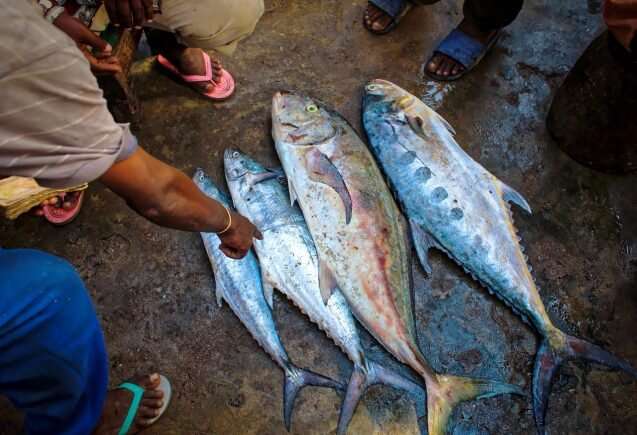Grim projections for the ocean—and the life within it

The chain of causation that connects rising concentrations of greenhouse gases in the atmosphere to the marine biota has been made clearer by the Intergovernmental Panel on Climate Change (IPCC) report "Special Report on Climate Change and Oceans and the Cryosphere." It was released on September 25 and examines the effects of increasing concentrations of greenhouse gases on the global oceans and the polar ice sheets.
While in the past the IPCC has been regarded as conservative about environmental change forced by climate change, the new summary of research has a more alarmed tone.
Sonya Dyhrman, a microbial oceanographer at Lamont-Doherty Earth Observatory and a scientist affiliated with the Center for Climate and Life, is interested in the relationship between phytoplankton, the primary producers of the sunlit depths of the ocean, and their geochemical environment.
When queried in early September, Dyhrman had not read the draft of the IPCC report leaked in August to a French news agency. But her response to the question "How has the marine phytoplankton community fared in response to changes in the physical environment that can be attributed to anthropogenic climate change?" foreshadowed the content of the report.
"There is no short answer about phytoplankton and the future ocean, but they are obviously critically important to the carbon cycle and food webs. While there are already some clear changes in ocean pH and temperature—changes in primary production and species composition are very hard to track in any comprehensive way—so detecting changes due to climate is a challenge."
In the nine-page executive summary that begins chapter five of the IPCC report, the authors state "In response to ocean warming and increased stratification, open ocean nutrient cycles are being perturbed and there is high confidence that this is having a regionally variable impact on primary producers."
For the IPCC to declare "high confidence" there must be robust evidence and much agreement among sources of data.
The IPCC report identifies two trends in the ocean, warming and acidification, as the hydrosphere absorbs both heat and carbon dioxide from the atmosphere. The authors state baldly, "The ocean has warmed unabated since 2005, continuing the clear multi-decadal ocean warming trends documented in the IPCC Fifth Assessment Report (AR5)." Not only has acidification been shown via multiple datasets and models have increased but the rate of carbon dioxide uptake to be accelerating over the past two decades as atmospheric concentrations have climbed.
As a consequence of warming and other physical and biogeochemical processes (including declining pH) the oxygen content of the open ocean is declining, very likely by 0.5 to 3.3 percent between 1970 and 2010, according to the report. The decline in available oxygen suggests that environmental changes are affecting the primary producers, which convert carbon dioxide into oxygen as a byproduct of cell maintenance and growth.
"The two main questions," said Dyhrman, "center around how much primary production will change and how will species composition change and over what timescales. Modeling-based predictions vary widely in part because there are still major knowledge gaps regarding the drivers of phytoplankton dynamics and how they will change in the future."
Dyhrman referred to a recent study of ocean color by Stephanie Dutkiewicz of MIT and several co-authors. The study used satellite observations collected since the late 1990s to model shifts in ocean color caused by changes in the phytoplankton community. By 2100 the model suggests low-latitude oceans will be bluer because of a decline in phytoplankton numbers. In contrast, continued warming will cause high-latitude oceans to become greener as more diverse and denser phytoplankton communities develop.
"Changes in species composition may sound insignificant," Dyhrman said, "but we could accidentally select for harmful species, and we can all appreciate that such a shift in primary producers on land are big deal—for example, grasslands support a very different ecosystem than a forest."
According to the IPCC report, the "observed rate of range shifts since the 1950s and its very likely range are estimated to be 51.5±33.3 kilometers (32 miles) per decade and 29.0±15.5 kilometers (18 miles) per decade for organisms in the epipelagic and seafloor ecosystems, respectively. The direction of the majority of the shifts of epipelagic organisms are consistent with a response to warming."
In addition to disruptions caused by range shifting, the IPCC report suggests, "Ocean warming and changes in primary production in the 20th century are related to changes in productivity of many fish stocks, with an average decrease of approximately 3 percent per decade in population replenishment and 4.1 percent (very likely range of 9.0 percent decline to 0.3 percent increase) in maximum catch potential. Species composition of fisheries catches since the 1970s in many shelf seas ecosystems of the world is increasingly dominated by warm-water species."
"Some models," said Dyhrman, citing a 2018 study by J. Keith Moore and others, "suggest major reductions in primary production and thus fish stocks by 2030 with a re-distribution of the nutrients that fuel primary production. This is by no means a certainty, but is arguably one more reason to view our changing climate as the crisis that it is."
Provided by Earth Institute, Columbia University
This story is republished courtesy of Earth Institute, Columbia University http://blogs.ei.columbia.edu.


















